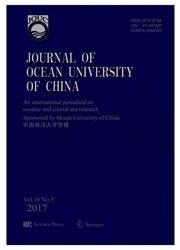

 中文摘要:
中文摘要:
Characteristics of a microbial community are important as they indicate the status of aquatic ecosystems. In the present study, the metabolic and phylogenetic profile of the bacterioplankton community in Guishan coastal water(Pearl River Estuary), South China Sea, at 12 sites(S1–S12) were explored by community-level physiological profiling(CLPP) with BIOLOG Eco-plate and denaturing gradient gel electrophoresis(DGGE). Our results showed that the core mariculture area(S6, S7 and S8) and the sites associating with human activity and sewage discharge(S11 and S12) had higher microbial metabolic capability and bacterial community diversity than others(S1–5, S9–10). Especially, the diversity index of S11 and S12 calculated from both CLPP and DGGE data(H >3.2) was higher than that of others as sewage discharge may increase water nitrogen and phosphorus nutrient. The bacterial community structure of S6, S8, S11 and S12 was greatly influenced by total phosphorous, salinity and total nitrogen. Based on DGGE fingerprinting, proteobacteria, especially γ- and α-proteobacteria, were found dominant at all sites. In conclusion, the aquaculture area and wharf had high microbial metabolic capability. The structure and composition of bacterial community were closely related to the level of phosphorus, salinity and nitrogen.更多还原
 英文摘要:
英文摘要:
Characteristics of a microbial community are important as they indicate the status of aquatic ecosystems. In the present study, the metabolic and phylogenetic profile of the bacterioplankton community in Guishan coastal water(Pearl River Estuary), South China Sea, at 12 sites(S1–S12) were explored by community-level physiological profiling(CLPP) with BIOLOG Eco-plate and denaturing gradient gel electrophoresis(DGGE). Our results showed that the core mariculture area(S6, S7 and S8) and the sites associating with human activity and sewage discharge(S11 and S12) had higher microbial metabolic capability and bacterial community diversity than others(S1–5, S9–10). Especially, the diversity index of S11 and S12 calculated from both CLPP and DGGE data(H 3.2) was higher than that of others as sewage discharge may increase water nitrogen and phosphorus nutrient. The bacterial community structure of S6, S8, S11 and S12 was greatly influenced by total phosphorous, salinity and total nitrogen. Based on DGGE fingerprinting, proteobacteria, especially γ- and α-proteobacteria, were found dominant at all sites. In conclusion, the aquaculture area and wharf had high microbial metabolic capability. The structure and composition of bacterial community were closely related to the level of phosphorus, salinity and nitrogen.
 同期刊论文项目
同期刊论文项目
 同项目期刊论文
同项目期刊论文
 Community level phisiological study of algicidal bacteria in the phycosphere of Skeletonema costatum
Community level phisiological study of algicidal bacteria in the phycosphere of Skeletonema costatum Selenium accumulation in unicellular green alga Chlorella vulgaris and its effects on antioxidant en
Selenium accumulation in unicellular green alga Chlorella vulgaris and its effects on antioxidant en Seasonal Changes in the Invertebrate Community of Granular Activated Carbon Filters and Control Tech
Seasonal Changes in the Invertebrate Community of Granular Activated Carbon Filters and Control Tech Inhibition of marine coastal bloom-forming phytoplankton by commercially cultivated Gracilaria leman
Inhibition of marine coastal bloom-forming phytoplankton by commercially cultivated Gracilaria leman 期刊信息
期刊信息
